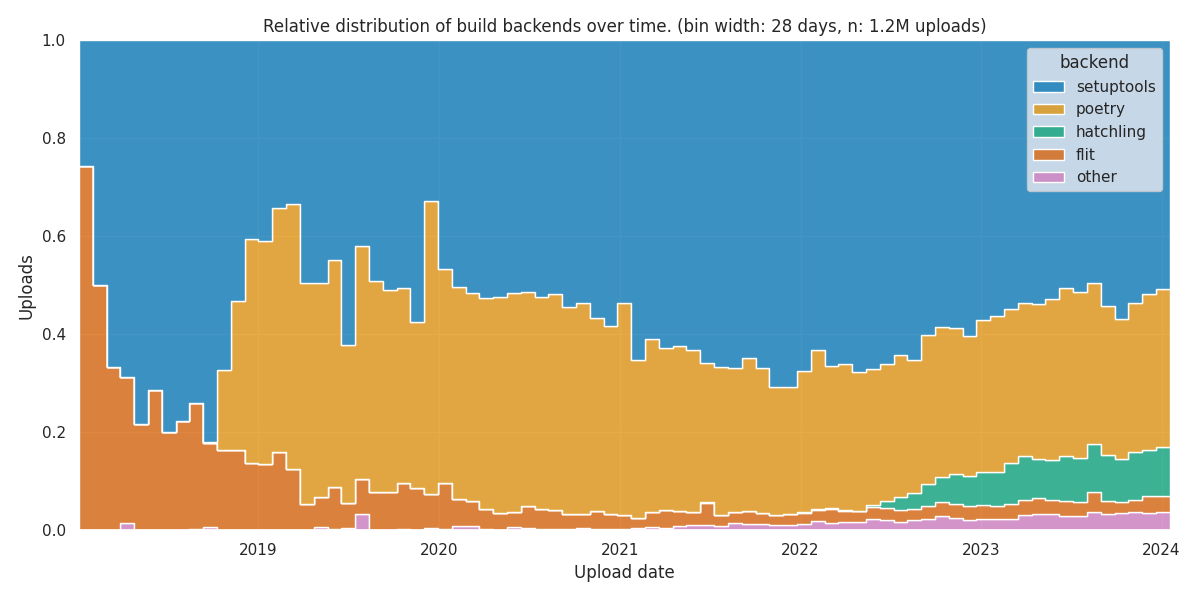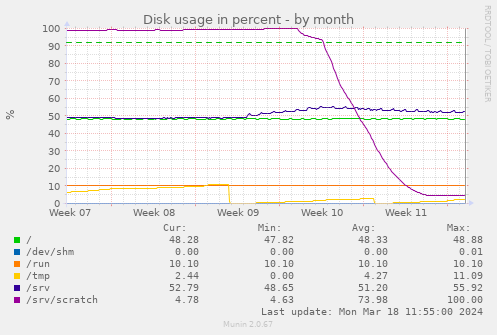
Inspired by a
Mastodon
post by Fran oise Conil,
who investigated the current popularity of build backends used in
pyproject.toml files, I wanted to investigate how the popularity of build
backends used in
pyproject.toml files evolved over the years since the
introduction of
PEP-0517 in 2015.
Getting the data
Tom Forbes provides a huge
dataset that contains information
about every file within every release uploaded to
PyPI. To
get the current dataset, we can use:
curl -L --remote-name-all $(curl -L "https://github.com/pypi-data/data/raw/main/links/dataset.txt")
This will download approximately 30GB of parquet files, providing detailed
information about each file included in a PyPI upload, including:
- project name, version and release date
- file path, size and line count
- hash of the file
The dataset does not contain the actual files themselves though, more on that
in a moment.
Querying the dataset using duckdb
We can now use
duckdb to query the parquet files directly. Let s look into
the schema first:
describe select * from '*.parquet';
column_name column_type null
varchar varchar varchar
project_name VARCHAR YES
project_version VARCHAR YES
project_release VARCHAR YES
uploaded_on TIMESTAMP YES
path VARCHAR YES
archive_path VARCHAR YES
size UBIGINT YES
hash BLOB YES
skip_reason VARCHAR YES
lines UBIGINT YES
repository UINTEGER YES
11 rows 6 columns
From all files mentioned in the dataset, we only care about
pyproject.toml
files that are in the project s root directory. Since we ll still have to
download the actual files, we need to get the
path and the
repository to
construct the corresponding URL to the mirror that contains all files in a
bunch of huge git repositories. Some files are not available on the mirrors; to
skip these, we only take files where the
skip_reason is empty. We also care
about the timestamp of the upload (
uploaded_on) and the
hash to avoid
processing identical files twice:
select
path,
hash,
uploaded_on,
repository
from '*.parquet'
where
skip_reason == '' and
lower(string_split(path, '/')[-1]) == 'pyproject.toml' and
len(string_split(path, '/')) == 5
order by uploaded_on desc
This query runs for a few minutes on my laptop and returns ~1.2M rows.
Getting the actual files
Using the
repository and
path, we can now construct an URL from which we
can fetch the actual file for further processing:
url = f"https://raw.githubusercontent.com/pypi-data/pypi-mirror- repository /code/ path "
We can download the individual
pyproject.toml files and parse them to read
the
build-backend into a dictionary mapping the file-
hash to the build
backend. Downloads on
GitHub are rate-limited, so downloading 1.2M files
will take a couple of days. By skipping files with a hash we ve already
processed, we can avoid downloading the same file more than once, cutting the
required downloads by circa 50%.
Results
Assuming the data is complete and my analysis is sound, these are the findings:
There is a surprising amount of build backends in use, but the overall amount
of uploads per build backend decreases quickly, with a long tail of single
uploads:
>>> results.backend.value_counts()
backend
setuptools 701550
poetry 380830
hatchling 56917
flit 36223
pdm 11437
maturin 9796
jupyter 1707
mesonpy 625
scikit 556
...
postry 1
tree 1
setuptoos 1
neuron 1
avalon 1
maturimaturinn 1
jsonpath 1
ha 1
pyo3 1
Name: count, Length: 73, dtype: int64
We pick only the top 4 build backends, and group the remaining ones (including
PDM and
Maturin) into other so they are accounted for as well.
The following plot shows the relative distribution of build backends over time.
Each bin represents a time span of 28 days. I chose 28 days to reduce visual
clutter. Within each bin, the height of the bars corresponds to the relative
proportion of uploads during that time interval:

Looking at the right side of the plot, we see the current distribution. It
confirms Fran oise s findings about the current popularity of build
backends:
- Setuptools: ~50%
- Poetry: ~33%
- Hatch: ~10%
- Flit: ~3%
- Other: ~4%
Between 2018 and 2020 the graph exhibits significant fluctuations, due to the
relatively low amount uploads utizing
pyproject.toml files. During that early
period,
Flit started as the most popular build backend, but was eventually
displaced by
Setuptools and
Poetry.
Between 2020 and 2020, the overall usage of
pyproject.toml files increased
significantly. By the end of 2022, the share of
Setuptools peaked at 70%.
After 2020, other build backends experienced a gradual rise in popularity.
Amongh these,
Hatch emerged as a notable contender, steadily gaining
traction and ultimately stabilizing at 10%.
We can also look into the absolute distribution of build backends over time:

The plot shows that Setuptools has the strongest growth trajectory, surpassing
all other build backends. Poetry and Hatch are growing at a comparable rate,
but since Hatch started roughly 4 years after Poetry, it s lagging behind in
popularity. Despite not being among the most widely used backends anymore, Flit
maintains a steady and consistent growth pattern, indicating its enduring
relevance in the Python packaging landscape.
The script for downloading and analyzing the data can be found in my
GitHub
repository. It contains the results of the duckb query (so you
don t have to download the full dataset) and the pickled dictionary, mapping
the file hashes to the build backends, saving you days for downloading and
analyzing the
pyproject.toml files yourself.
 This article is cross-posting from grow-your-ideas. This is just an idea.
salsa.debian.org
This article is cross-posting from grow-your-ideas. This is just an idea.
salsa.debian.org
 ref. https://qa.debian.org/dose/debcheck/unstable_main/index.html
ref. https://qa.debian.org/dose/debcheck/unstable_main/index.html
 ref. https://qa.debian.org/dose/debcheck/unstable_main/index.html
ref. https://qa.debian.org/dose/debcheck/unstable_main/index.html
 The Amazon Kids parental controls are extremely insufficient, and I strongly advise against getting any of the Amazon Kids series.
The initial permise (and some older reviews) look okay: you can set some time limits, and you can disable anything that requires buying.
With the hardware you get one year of the Amazon Kids+ subscription, which includes a lot of interesting content such as books and audio,
but also some apps. This seemed attractive: some learning apps, some decent games.
Sometimes there seems to be a special Amazon Kids+ edition , supposedly one that has advertisements reduced/removed and no purchasing.
However, there are so many things just wrong in Amazon Kids:
The Amazon Kids parental controls are extremely insufficient, and I strongly advise against getting any of the Amazon Kids series.
The initial permise (and some older reviews) look okay: you can set some time limits, and you can disable anything that requires buying.
With the hardware you get one year of the Amazon Kids+ subscription, which includes a lot of interesting content such as books and audio,
but also some apps. This seemed attractive: some learning apps, some decent games.
Sometimes there seems to be a special Amazon Kids+ edition , supposedly one that has advertisements reduced/removed and no purchasing.
However, there are so many things just wrong in Amazon Kids:
 Debian is running a "
Debian is running a " The initial dip from 100% to 95% is my first "what happens if we block repos
> 500 MB" attempt. Over the week after that, the git filter clones reduce the
overall disk consumption from almost 300 GB to 15 GB, a 1/20. Some
repos shrank from GBs to below a MB.
Perhaps I should make all my git clones use one of the filters.
The initial dip from 100% to 95% is my first "what happens if we block repos
> 500 MB" attempt. Over the week after that, the git filter clones reduce the
overall disk consumption from almost 300 GB to 15 GB, a 1/20. Some
repos shrank from GBs to below a MB.
Perhaps I should make all my git clones use one of the filters.
 Closing arguments in the trial between various people and
Closing arguments in the trial between various people and 
 Like each month, have a look at the work funded by
Like each month, have a look at the work funded by  I like using one machine and setup for everything, from serious development work to hobby projects to managing my finances. This is very convenient, as often the lines between these are blurred. But it is also scary if I think of the large number of people who I have to trust to not want to extract all my personal data. Whenever I run a
I like using one machine and setup for everything, from serious development work to hobby projects to managing my finances. This is very convenient, as often the lines between these are blurred. But it is also scary if I think of the large number of people who I have to trust to not want to extract all my personal data. Whenever I run a 












 I had finished sewing my jeans, I had a scant 50 cm of elastic denim
left.
Unrelated to that, I had just finished drafting a vest with Valentina,
after
I had finished sewing my jeans, I had a scant 50 cm of elastic denim
left.
Unrelated to that, I had just finished drafting a vest with Valentina,
after 

 The other thing that wasn t exactly as expected is the back: the pattern
splits the bottom part of the back to give it sufficient spring over
the hips . The book is probably published in 1892, but I had already
found when drafting the foundation skirt that its idea of hips
includes a bit of structure. The enough steel to carry a book or a cup
of tea kind of structure. I should have expected a lot of spring, and
indeed that s what I got.
To fit the bottom part of the back on the limited amount of fabric I had
to piece it, and I suspect that the flat felled seam in the center is
helping it sticking out; I don t think it s exactly bad, but it is
a peculiar look.
Also, I had to cut the back on the fold, rather than having a seam in
the middle and the grain on a different angle.
Anyway, my next waistcoat project is going to have a linen-cotton lining
and silk fashion fabric, and I d say that the pattern is good enough
that I can do a few small fixes and cut it directly in the lining, using
it as a second mockup.
As for the wrinkles, there is quite a bit, but it looks something that
will be solved by a bit of lightweight boning in the side seams and in
the front; it will be seen in the second mockup and the finished
waistcoat.
As for this one, it s definitely going to get some wear as is, in casual
contexts. Except. Well, it s a denim waistcoat, right? With a very
different cut from the get a denim jacket and rip out the sleeves , but
still a denim waistcoat, right? The kind that you cover in patches,
right?
The other thing that wasn t exactly as expected is the back: the pattern
splits the bottom part of the back to give it sufficient spring over
the hips . The book is probably published in 1892, but I had already
found when drafting the foundation skirt that its idea of hips
includes a bit of structure. The enough steel to carry a book or a cup
of tea kind of structure. I should have expected a lot of spring, and
indeed that s what I got.
To fit the bottom part of the back on the limited amount of fabric I had
to piece it, and I suspect that the flat felled seam in the center is
helping it sticking out; I don t think it s exactly bad, but it is
a peculiar look.
Also, I had to cut the back on the fold, rather than having a seam in
the middle and the grain on a different angle.
Anyway, my next waistcoat project is going to have a linen-cotton lining
and silk fashion fabric, and I d say that the pattern is good enough
that I can do a few small fixes and cut it directly in the lining, using
it as a second mockup.
As for the wrinkles, there is quite a bit, but it looks something that
will be solved by a bit of lightweight boning in the side seams and in
the front; it will be seen in the second mockup and the finished
waistcoat.
As for this one, it s definitely going to get some wear as is, in casual
contexts. Except. Well, it s a denim waistcoat, right? With a very
different cut from the get a denim jacket and rip out the sleeves , but
still a denim waistcoat, right? The kind that you cover in patches,
right?
 Two months into my
Two months into my  We are thrilled to share that
We are thrilled to share that  In light of the recent
In light of the recent 






 Insert obligatory "not THAT data" comment here
Insert obligatory "not THAT data" comment here
 If you don't know who Professor Julius Sumner Miller is, I highly recommend
If you don't know who Professor Julius Sumner Miller is, I highly recommend  No thanks, Bender, I'm busy tonight
No thanks, Bender, I'm busy tonight
 Inspired by a
Inspired by a 
